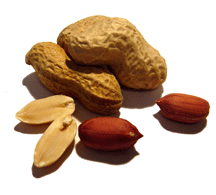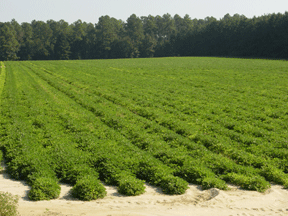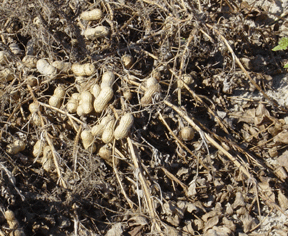


|
|
|
PEANUTS (Arachis Hypogaea) 
raw peanuts Peanut HistoryThe peanut plant is believed to have originated most likely in Brazil or Peru. While there are no fossil records to prove this theory, the oldest known evidence of peanuts come from this area. The earliest known evidence of their existence come in the form of pottery created in South America around 3,500 years ago. Numerous jars have been found that have both been created in the shape of a peanut and decorated with them. No earlier evidence has ever come to light from anywhere in the world, leading scientists to believe this was the point of origin. Peanuts were clearly a staple in the diets of many of the indigenous peoples of the time. This is apparent from the finds of the archeaologists who have studied the region. One of the most telling signs of the importance of the peanut as a food source is the fact that many Ancient Inca graves that have been discovered along the very arid western coast of South America that contain jars filled with peanuts which were to serve as food in the afterlife. By the time the Spanish began their exploration of the New World, peanuts were being cultivated as far North as modern day Mexico. When the Spanish explorers discovered the tasty legume they promptly developed an affinity for the plant and took it back to Spain with them when they returned. In this era, Spain was a major world power with colonies all over the world. Once the peanut reached Spain, traders and merchants quickly ensured its rapid immigration into other regions of the world, such as Africa and Asia. In Africa, the plant became quite common in the western tropical region. Africans regarded the peanut very highly, even to the point that it was considered as one of several plants to have a soul. When the American colonies were beginning to look as though they might prosper the first slaves were brought from Africa to North America. When the slaves first began arriving in North America they brought the peanut with them. They were then planted throughout the Southern United States. The peanut gets one of its most frequently used monikers from this era and from the slaves who brought them. The peanut is often called a goober or goober pea. Goober comes for the Congo word for peanut, which is nguba. In the 1700's peanuts were determined to be an excellent source of food for pigs. Thus there began to be slightly more production in the new world. Around the turn of the 19th Century, South Carolina records show that there was commercial production of peanuts for oil, food and even as a substitute for cocoa. Still, despite this, the peanut was not being grown in any large scale quantities due to the facts that the peanut was slow and laborious to grow and harvest and because it was viewed as food for the poor. It was not until the beginning of the 20th Century that the peanut began to be more extensively grown due largely to the increase of new equipment that dramatically reduced the labor costs of growing and harvesting peanuts. Peanuts were not largely considered a popular food source for people during the majority of the 19th century because peanuts were still harvested by hand. This meant that there was almost always stems and trash in the peanuts. This poor quality and lack of a uniform product resulted in a fairly small demand for peanuts in this era. In 1860 however, the first notable increase in demand occurred. The Civil War had begun and peanuts were a cheap, relatively nonperishable food item that was easily transportable. These qualities made it an ideal food stuff for the governments of both the North and South to use to feed their soldiers. By the turn of the 20th century new mechanized means of farming peanuts were being invented and becoming available to many farmers around the United States. This new equipment greatly lessened the burdens of planting, cultivating, harvesting, and picking peanuts from the plants. Even more new technologies would improve their ability to rapidly and cleanly shell and clean the kernels. These new inventions changed the face of the peanut market. For the first time, farming peanuts was economically feasible to many farmers who did not wish to invest the time or labor to produce a crop with only a minimal financial return. It was now much cheaper to produce, and, due to the increase in uniformity and quality, was also in considerable higher demand. The demand for peanuts was for food, but also for the oil. In 1903, further demand for peanuts was created as George Washington Carver began his famous research on peanuts at the Tuskeegee Institute, highlighted by his invention of peanut butter. His research lead to a great many discovery's. He discovered numerous improvements in horticulture and developed more than 300 uses for the peanut including such uses as shoe polish and shaving cream. Carver recognized the value of the peanut plant as a cash crop and persuaded many in the South to plant peanuts as an alternative to cotton, which at this time was facing a serious threat due to boll weevil infestation. Through Carver's diligent efforts, peanuts became the huge part of Southern agriculture that it is today.
peanuts at maturity Peanut UsesWhile the peanut does have many uses, by far and away its biggest use is for food items. Your most likely reference when thinking of peanuts is peanut butter, or perhaps the salted or roasted peanuts you might get at a ball game. Its use as a food source comprises the bulk of its public consumption, but peanuts can be and often are used for other purposes as well. Just as with cotton, as much of the plant that can be used, is used. The hulls or pods as they are sometimes called can quite often be used as a fuel source. They are also used in kitty litter. The oil that peanuts produce is also a common item produced and consumed form the plant. Many restaurants and individuals now use peanut oil as opposed to animal fats to do any deep frying. The reason behind this is because the oil found in peanuts is much lower in saturated fats than animal fat based oil many used to use. As a result it is far more heart healthy. Many of your favorite fast food restaurants have made this change in an effort to make a healthier product for their customers. The peanut oil is also used for a variety of industrial products. Paint, varnish, lubricating oil, furniture polish, insecticides, and even nitroglycerin are made from this oil. Another use for peanuts is in making soaps. The peanut kernels that are not used in foods are often used in this purpose. These are just some of the many uses of peanuts. There are many more but these are the ones most likely to be used by the average consumer. The truth of the matter is that whatever the ultimate use, peanuts play a major part of the agricultural economy in the United States. They are a large and plentiful food supply to many in our country and over seas. Peanuts are a very important crop to this region of the United States and here in the CSRA. In order to understand how important peanuts have become one only need to look at the Georgia's moniker. It may be called the "Peach State", but it has long since been producing vastly larger quantities of peanuts than it has peaches.
peanuts drying in the field Facts on Peanuts and Peanut PlantingThe first question to answer on peanuts is, precisely what are peanuts? Well, although they are called nuts, they are in fact not in the nut family but in the pea family (Family Fabaceae). The fruit that you actually eat is not a fruit, but in fact a legume or pod. The peanut is an unusual plant because it flowers above ground but fruits beneath the ground. There are many common misconceptions of peanuts and how they grow. Many common misconceptions place them growing on trees or growing as a part of the root, similar to a potato. In fact it is like none of the above. Peanuts grow much like any other row crop. It is in the fruiting process where it does something different. Peanuts grow from seeds into a small bushy crop, usually about 18 inches tall. As they approach maturity they develop small yellow flowers. The flowers pollinate themselves, lose their petals and then the ovary begins to enlarge. The budding ovary grows larger and is pulled by gravity closer to the ground. The peanut embryo is in the tip of the ovary or "peg" and it penetrates the soil as it reaches the ground. The embryo then turns horizontal to the soil surface and eventually matures into a peanut. This entire process will take somewhere between four and five months depending on the variety. There are four types of peanuts that are most popular and most commonly used throughout the world. They are the Spanish, Runner, Virginia, and Valencia varieties. These constitute the bulk of the types of peanuts planted around the world. There are also a few other varieties, such as Tennessee Red and Tennessee white types. The type of peanut one grows depends on two main factors, what your climate and soil type is, and what you want the final use of your peanuts to be. Certain types of peanuts are preferred for particular uses due to differences in flavor, oil content, size and shape. For example, the majority of the peanuts marketed in the shell (i.e. salted peanuts you might buy at the ball park) are of the Virginia type with a few coming from the Valencia variety. Spanish peanuts are mainly used in the manufacture of peanut candy. Runners are mainly used to make peanut butter. In the Southeastern states of Georgia, Florida, Alabama and South Carolina over 90 percent of the peanuts grown are in the runner variety. The reason for this is due to this variety's excellent drought tolerance and response to irrigation. It also can be grown effectively in very different ranges of soils from sandy to heavy textured clay soils. It has excellent flavor characteristics to go along with its ease of shelling and processing. These factors have made this particular variety one of the more marketable and successful varieties in the world. Peanuts grow to the highest grade and produce the best yields in loose, well drained soils. On the other hand, peanuts do not respond particularly well in badly drained or tight soils, and all varieties are particularly susceptible to frosts. For this reason, the ideal planting dates in our area are between April 20 and May 20. This allows harvest to fall between the last week in August and the first week in October. Also important to note is that peanut yields can drop by as much as 10% each time the plants are continuously cultivated on the same tract of land. As such, you will often find that peanuts are grown in a rotation with other crops. In Georgia, Alabama, and Florida peanut farmers consistently grow peanuts and sell them at a total value in excess of $500 million dollars. While this is a large sum there are numerous costs involved as well. The average peanut farmer in the Southeast spends between $550 and $700 an acre to raise their crop. When considering that the average grower has 90 acres in peanut production that farmer will outlay approximately $57,000 in production costs. These expenses accumulate from applying fungicides, insecticides, herbicides, seed, machinery and fertilizers. What about peanuts in our immediate area? Well, peanuts grown in Georgia comprise about 40 percent of total acreage and production of all peanuts grown in the United States. Burke County, Georgia produces more than any other county in this area by growing 24,375,000 lbs. of peanuts in 2002 with a value of approximately $6,199,000. It produces by far the most peanuts of any county in the CSRA. The combined total for our region is nearing $11,000,000 in peanut production in 2002 alone. |